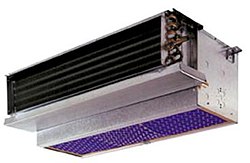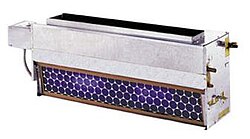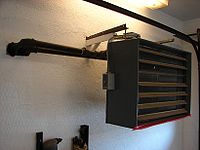Which Service Should Be Performed On The Air Side Components Of The Indoor Fan Coil Unit?

Refrigerant based Fan-Coil Unit. Other variants utilize a chilled, or heated water loop for space cooling, or heating, respectively.


A fan coil unit of measurement (FCU), also known as a Vertical Fan Coil-Unit (VFC), is a device consisting of a heat exchanger (coil) and a fan. Every bit role of an HVAC system establish in residential, commercial, and industrial buildings using ducted dissever air workout or with central plant cooling, a fan coil unit is ofttimes continued to ductwork and a thermostat to regulate the temperature of ane or more than spaces as well as assisting the main air handling unit for each space if used with chillers. The thermostat controls the fan speed and/or the throughput of water to the oestrus exchanger using a control valve.
Attributable to their simplicity and flexibility, fan gyre units can exist more economic to install than ducted 100% fresh air systems (VAV) or central heating systems with air handling units or chilled beams. Various unit configurations are available, including horizontal (ceiling mounted) or vertical (flooring mounted).
Racket output from FCUs, like whatsoever other form of air conditioning, is principally due to the design of the unit of measurement and the edifice materials around it. Some offer noise levels as low as NR25 or NC25
The output from an FCU tin be established past looking at the temperature of the air entering the unit and the temperature of the air leaving the unit of measurement, coupled with the volume of air existence moved through the unit of measurement. This is a simplistic statement, and there is further reading on sensible heat ratios and the specific heat capacity of air, both of which have an effect on thermal performance.
Pattern and operation [edit]
Fan Curlicue Unit covers a range of products and will mean dissimilar things to users, specifiers, and installers in different countries and regions, particularly in relation to production size and output capability.
Fan Coil Unit falls principally into ii primary types: accident through and draw through. Equally the names advise, in the outset type the fans are fitted behind the oestrus exchanger, and in the other type the fans are fitted in front the whorl such that they draw air through information technology. Describe through units are considered thermally superior, as commonly they make better use of the rut exchanger. However they are more expensive, as they require a chassis to hold the fans whereas a blow-through unit typically consists of a prepare of fans bolted directly to a coil.
A fan coil unit may exist concealed or exposed within the room or area that information technology serves.
An exposed fan coil unit of measurement may be wall-mounted, freestanding or ceiling mounted, and volition typically include an appropriate enclosure to protect and conceal the fan coil unit itself, with return air grille and supply air diffuser set into that enclosure to distribute the air.
A concealed fan ringlet unit will typically exist installed inside an accessible ceiling void or services zone. The render air grille and supply air diffuser, typically set affluent into the ceiling, will be ducted to and from the fan curl unit of measurement and thus allows a bully caste of flexibility for locating the grilles to conform the ceiling layout and/or the segmentation layout inside a space. It is quite common for the return air not to exist ducted and to use the ceiling void equally a return air plenum.
The coil receives hot or common cold h2o from a central plant, and removes oestrus from or adds heat to the air through heat transfer. Traditionally fan scroll units can contain their ain internal thermostat, or can be wired to operate with a remote thermostat. Nevertheless, and as is common in most modern buildings with a Building Energy Management Organisation (BEMS), the control of the fan whorl unit volition be by a local digital controller or outstation (along with associated room temperature sensor and command valve actuators) linked to the BEMS via a communication network, and therefore adjustable and controllable from a central betoken, such every bit a supervisors caput cease computer.
Fan coil units broadcast hot or cold water through a coil in order to status a space. The unit of measurement gets its hot or common cold h2o from a primal found, or mechanical room containing equipment for removing heat from the central edifice'southward closed-loop. The equipment used tin can consist of machines used to remove heat such every bit a chiller or a cooling belfry and equipment for calculation heat to the building's water such as a boiler or a commercial water heater.
Hydronic fan whorl units can be generally divided into two types: Two-piping fan ringlet units or four-pipe fan ringlet units. Two-pipe fan coil units take one supply and i return pipage. The supply pipe supplies either cold or hot water to the unit depending on the time of year. Iv-pipage fan coil units accept ii supply pipes and ii return pipes. This allows either hot or cold water to enter the unit at whatsoever given time. Since it is frequently necessary to heat and cool different areas of a edifice at the same time, due to differences in internal heat loss or heat gains, the four-pipe fan coil unit is most usually used.
Fan scroll units may be connected to piping networks using various topology designs, such every bit "straight render", "reverse return", or "series decoupled". Encounter ASHRAE Handbook "2008 Systems & Equipment", Chapter 12.
Depending upon the selected chilled water temperatures and the relative humidity of the space, it is likely that the cooling coil volition dehumidify the inbound air stream, and as a past product of this process, it will at times produce a condensate which will demand to be carried to bleed. The fan curl unit will contain a purpose designed drip tray with drain connection for this purpose. The simplest ways to drain the condensate from multiple fan coil units will exist by a network of pipework laid to falls to a suitable point. Alternatively a condensate pump may be employed where infinite for such gravity pipework is limited.
Speed control of the fan motors within a fan scroll unit is partly used to control the heating and cooling output desired from the unit. Some manufacturers accomplish speed control by adjusting the taps on an Air-conditioning transformer supplying the power to the fan motor. Typically this would crave aligning at the commissioning stage of the building structure procedure and is therefore prepare for life at a fixed speed. Other manufacturers provide custom-wound Permanent Split up Capacitor (PSC) motors with speed taps in the windings, ready to the desired speed levels for the fan gyre unit pattern. A uncomplicated speed selector switch (Off-High-Medium-Low) is provided for the local room occupant to control the fan speed. Typically this speed selector switch is integral to the room thermostat, and is set manually or is controlled automatically by the digital room thermostat. Edifice Free energy Direction Systems can be used for automatic fan speed and temperature control. Fan motors are typically Air conditioning Shaded Pole or Permanent Dissever Capacitor. More recent developments include brushless DC designs with electronic commutation. Compared to units with asynchronous 3-speed motors, the fan roll units with brushless motors will reduce the power consumption up to 70%.[1]
Fan coil units linked to ducted split air-conditioning units use refrigerant in the cooling curlicue instead of chilled coolant and linked to a big condenser unit of measurement instead of a chiller. They might also be linked to liquid-cooled condenser units which utilize an intermediate coolant to cool the condenser using cooling towers.
DC/EC motor powered units [edit]
These motors are sometimes called DC motors, sometimes called EC motors and occasionally EC/DC motors. DC stands for Direct Electric current and EC stands for Electronically Commutated.
DC motors allow the speed of the fans inside a Fan Coil Unit of measurement to be controlled past means of a 0-ten Volt input 'Point' to the motor/s, the transformers and speed switches associated with AC Fan Coils are not required. Up to a signal voltage of 2.5 Volts (which may vary with different fan/motor manufacturers) the fan will exist in a stopped status but every bit the signal voltage is increased, the fan will seamlessly increase in speed until the maximum is reached at a signal Voltage of 10 Volts. Fan Coils will generally operate betwixt approximately iv Volts and 7.5 Volts considering below 4 Volts the air volumes are ineffective and higher up 7.five Volts the Fan Ringlet is likely to be as well noisy for well-nigh commercial applications.
The 0-10 Volt signal voltage tin can be fix via a uncomplicated potentiometer and left or the 0-10 Volt bespeak voltage can be delivered to the fan motors past the terminal controller on each of the Fan Roll Units. The former is very simple and inexpensive but the latter opens up the opportunity to continuously change the fan speed depending on various external conditions/influences. These weather/criteria could be the 'real fourth dimension' demand for either heating or cooling, occupancy levels, window switches, fourth dimension clocks or whatsoever number of other inputs from either the unit itself, the Building Management Arrangement or both.
The reason that these DC Fan Coil Units are, despite their apparent relative complexity, becoming more than popular is their improved energy efficiency levels compared to their Ac motor driven counterparts of only a few years agone. A straight swap, Ac to DC, will reduce electric consumption by 50% simply applying Demand and Occupancy dependent fan speed control tin can take the savings to as much every bit eighty%. In areas of the globe where there are legally enforceable energy efficiency requirements for Fan Coils (such as the UK), DC Fan Roll Units are rapidly becoming the only choice.
Areas of use [edit]


In loftier-rise buildings, fan coils may exist vertically stacked, located one in a higher place the other from floor to floor and all interconnected past the same piping loop.
Fan coil units are an excellent commitment machinery for hydronic chiller banality systems in large residential and light commercial applications. In these applications the fan coil units are mounted in bathroom ceilings and can be used to provide unlimited comfort zones - with the ability to plough off unused areas of the structure to save energy.
Installation [edit]
In high-rising residential construction, typically each fan gyre unit of measurement requires a rectangular through-penetration in the concrete slab on top of which it sits. Usually, there are either 2 or four pipes made of ABS, steel or copper that go through the floor. The pipes are unremarkably insulated with refrigeration insulation, such as acrylonitrile butadiene/polyvinyl chloride (AB/PVC) flexible cream (Rubatex or Armaflex brands) on all pipes, or at least on the chilled h2o lines to prevent condensate from forming.
Unit ventilator [edit]
A unit ventilator is a fan curl unit that is used mainly in classrooms, hotels, apartments and condominium applications. A unit ventilator can be a wall mounted or ceiling hung chiffonier, and is designed to use a fan to accident outside air beyond a coil, thus conditioning and ventilating the space which it is serving.
European market [edit]
The Fan Coil is composed of one quarter of 2-pipage-units and three quarters of 4-pipe-units, and the nearly sold products are "with casing" (35%), "without casing" (28%), "cassette" (18%) and "ducted" (sixteen%).[1]
The market by region was split in 2010 equally follows:
| Region | Sales Volume in units[2] | Share |
|---|---|---|
| Benelux | 33 725 | 2.half dozen% |
| French republic | 168 028 | 13.2% |
| Deutschland | 63 256 | 5.0% |
| Greece | 33 292 | 2.6% |
| Italian republic | 409 830 | 32.i% |
| Poland | 32 987 | two.6% |
| Portugal | 22 957 | one.8% |
| Russian federation, Ukraine and CIS countries | 87 054 | 6.8% |
| Scandinavia and Baltic countries | 39 124 | three.1% |
| Spain | 91 575 | 7.2% |
| Turkey | 70 682 | five.5% |
| Britain and Republic of ireland | 69 169 | 5.4% |
| Eastern Europe | 153 847 | 12.ane% |
See likewise [edit]
- Thermal insulation
- HVAC
- Construction
- Intumescent
- Firestop
References [edit]
- ^ Eurovent Market place Intelligence https://www.eurovent-marketintelligence.eu/
- ^ Eurovent Marketplace Intelligence https://www.eurovent-marketintelligence.eu/
Which Service Should Be Performed On The Air Side Components Of The Indoor Fan Coil Unit?,
Source: https://en.wikipedia.org/wiki/Fan_coil_unit
Posted by: baumobee1968.blogspot.com


0 Response to "Which Service Should Be Performed On The Air Side Components Of The Indoor Fan Coil Unit?"
Post a Comment